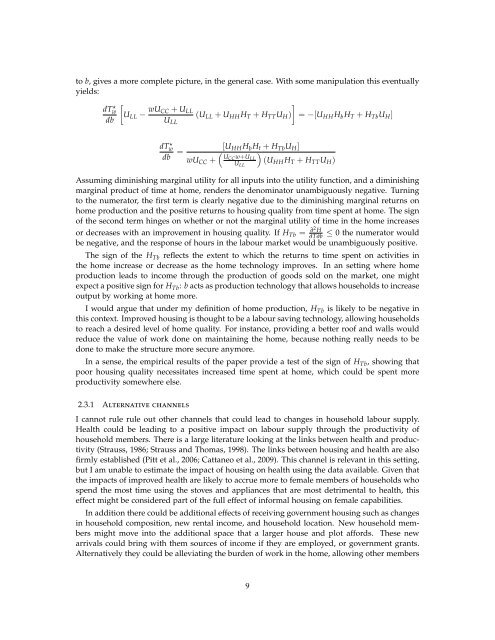1U08p2c
1U08p2c
1U08p2c
You also want an ePaper? Increase the reach of your titles
YUMPU automatically turns print PDFs into web optimized ePapers that Google loves.
to b, gives a more complete picture, in the general case. With some manipulation this eventually<br />
yields:<br />
dT ⋆ w<br />
db<br />
[<br />
U LL − wU ]<br />
CC + U LL<br />
(U LL + U HH H T + H TT U H ) = −[U HH H<br />
U b H T + H Tb U H ]<br />
LL<br />
dT ⋆ w<br />
db = [U HH H b H t + H Tb U H ]<br />
wU CC +<br />
(<br />
UCC w+U LL<br />
U LL<br />
)<br />
(U HH H T + H TT U H )<br />
Assuming diminishing marginal utility for all inputs into the utility function, and a diminishing<br />
marginal product of time at home, renders the denominator unambiguously negative. Turning<br />
to the numerator, the first term is clearly negative due to the diminishing marginal returns on<br />
home production and the positive returns to housing quality from time spent at home. The sign<br />
of the second term hinges on whether or not the marginal utility of time in the home increases<br />
or decreases with an improvement in housing quality. If H Tb = ∂2 H<br />
∂T∂b<br />
≤ 0 the numerator would<br />
be negative, and the response of hours in the labour market would be unambiguously positive.<br />
The sign of the H Tb reflects the extent to which the returns to time spent on activities in<br />
the home increase or decrease as the home technology improves. In an setting where home<br />
production leads to income through the production of goods sold on the market, one might<br />
expect a positive sign for H Tb : b acts as production technology that allows households to increase<br />
output by working at home more.<br />
I would argue that under my definition of home production, H Tb is likely to be negative in<br />
this context. Improved housing is thought to be a labour saving technology, allowing households<br />
to reach a desired level of home quality. For instance, providing a better roof and walls would<br />
reduce the value of work done on maintaining the home, because nothing really needs to be<br />
done to make the structure more secure anymore.<br />
In a sense, the empirical results of the paper provide a test of the sign of H Tb , showing that<br />
poor housing quality necessitates increased time spent at home, which could be spent more<br />
productivity somewhere else.<br />
2.3.1 Alternative channels<br />
I cannot rule rule out other channels that could lead to changes in household labour supply.<br />
Health could be leading to a positive impact on labour supply through the productivity of<br />
household members. There is a large literature looking at the links between health and productivity<br />
(Strauss, 1986; Strauss and Thomas, 1998). The links between housing and health are also<br />
firmly established (Pitt et al., 2006; Cattaneo et al., 2009). This channel is relevant in this setting,<br />
but I am unable to estimate the impact of housing on health using the data available. Given that<br />
the impacts of improved health are likely to accrue more to female members of households who<br />
spend the most time using the stoves and appliances that are most detrimental to health, this<br />
effect might be considered part of the full effect of informal housing on female capabilities.<br />
In addition there could be additional effects of receiving government housing such as changes<br />
in household composition, new rental income, and household location. New household members<br />
might move into the additional space that a larger house and plot affords. These new<br />
arrivals could bring with them sources of income if they are employed, or government grants.<br />
Alternatively they could be alleviating the burden of work in the home, allowing other members<br />
9


